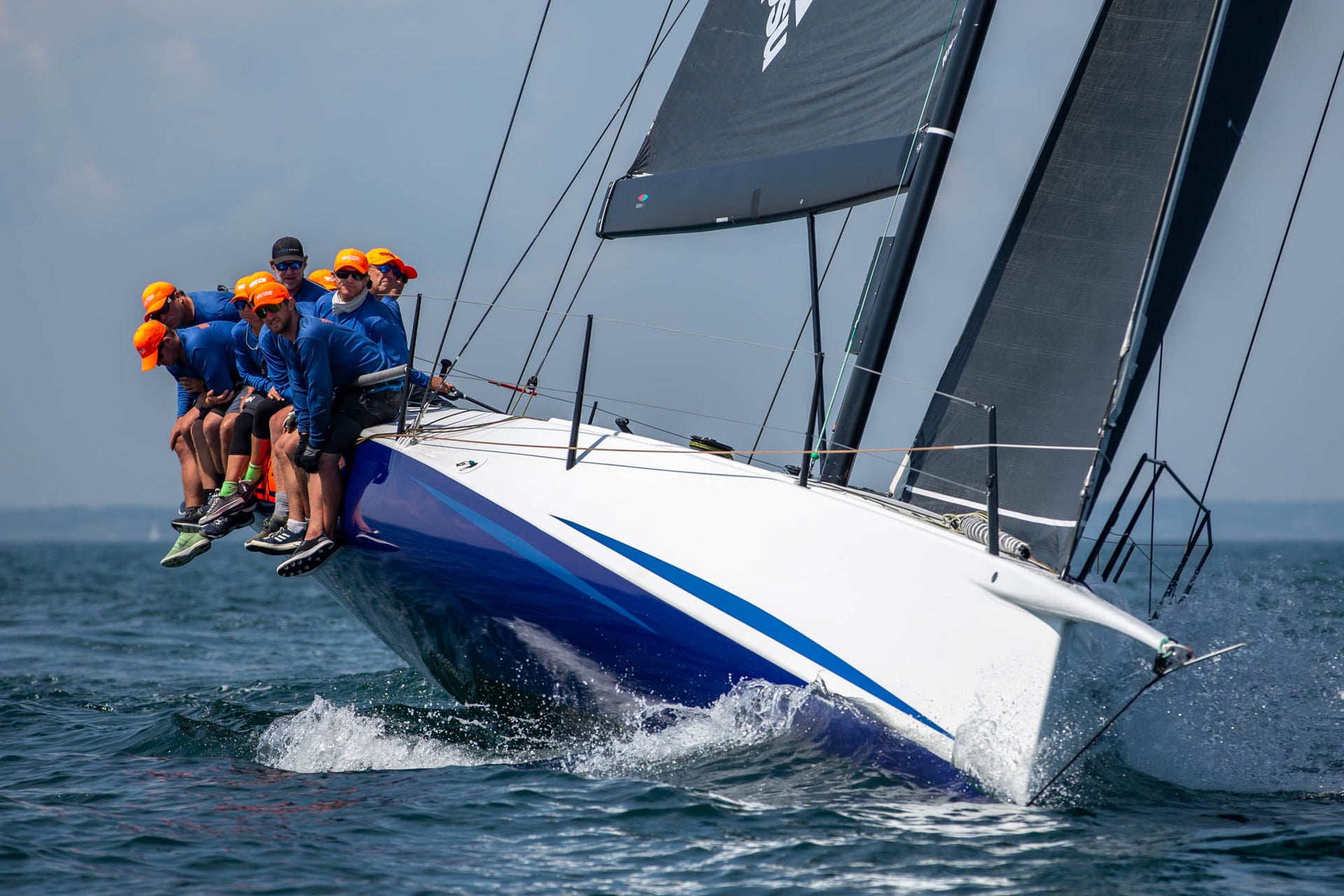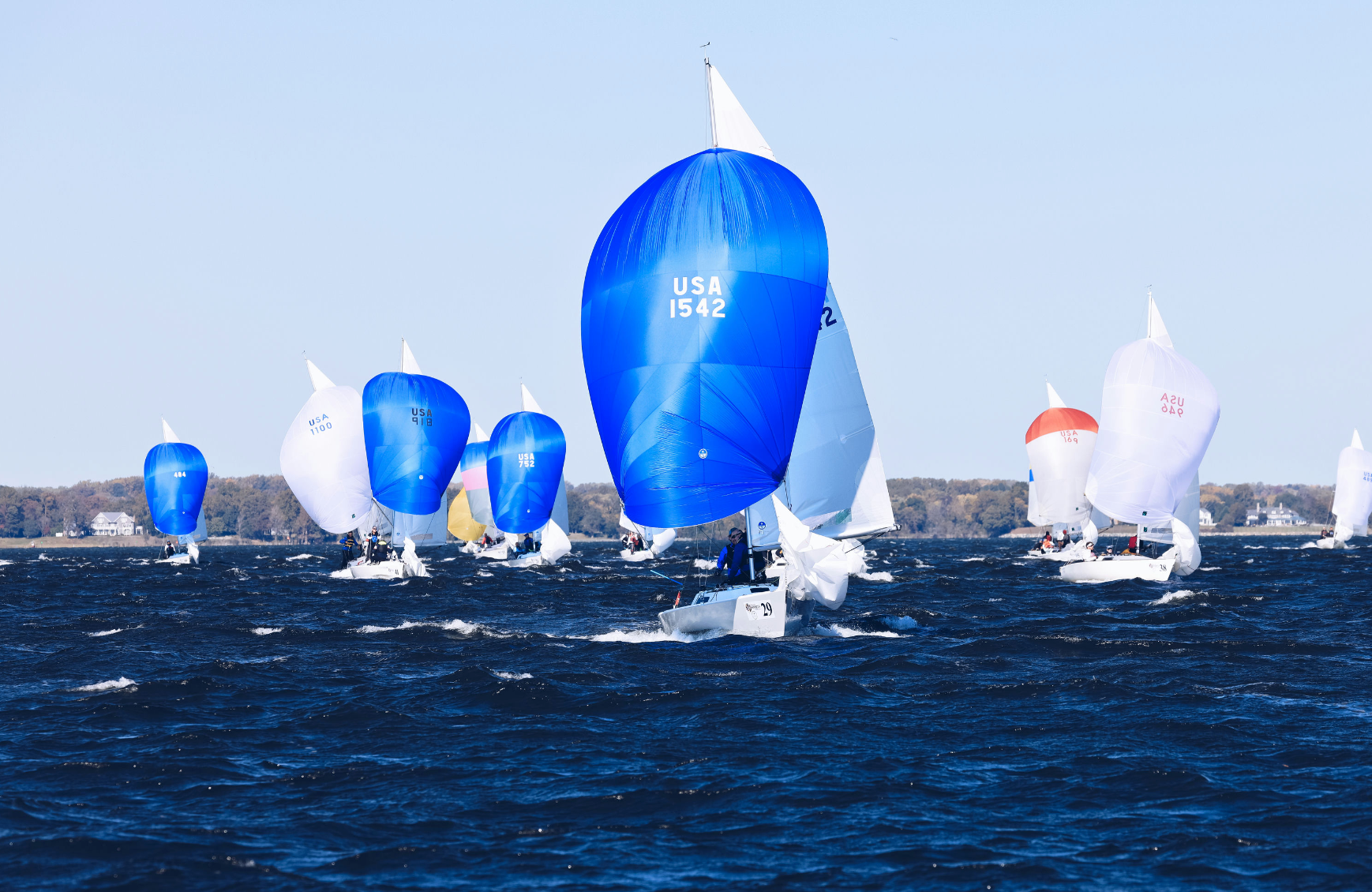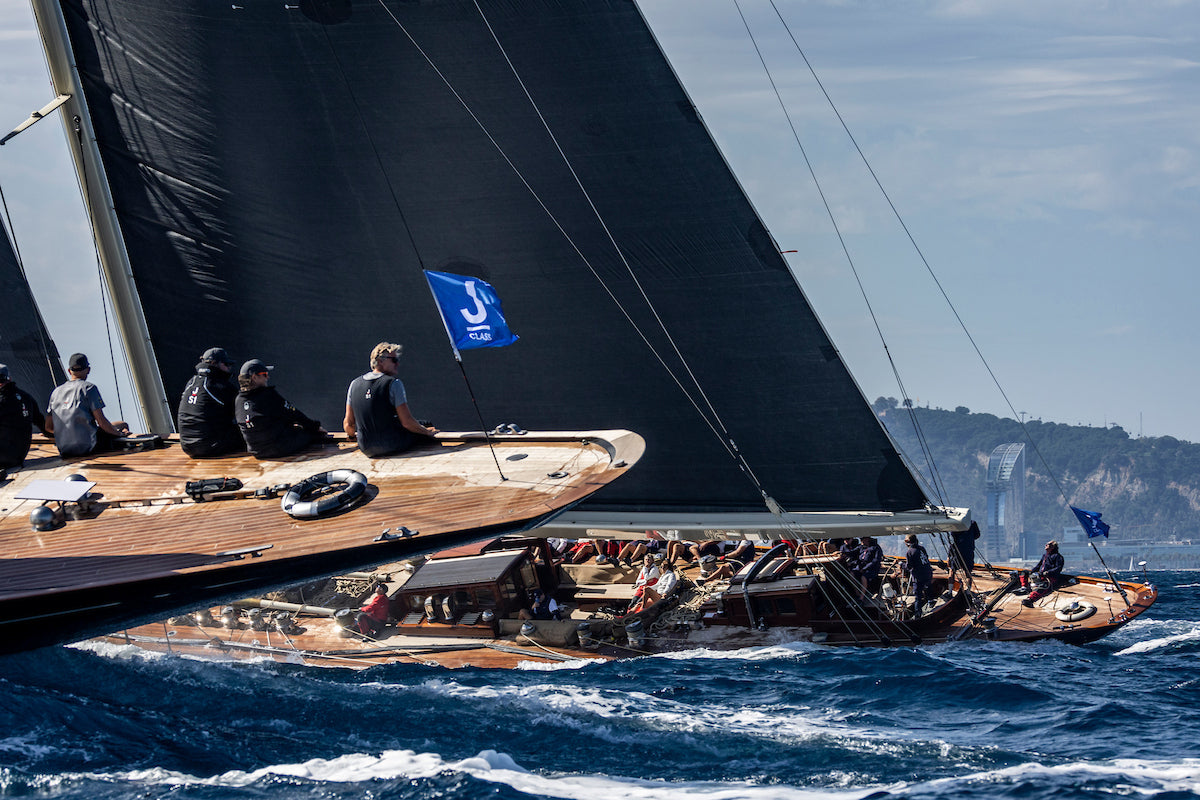TRIUMPH ON THE EDGE
TRIUMPH ON THE EDGE
John Bacon’s Recipe for Success at the New York Yacht Club Race Week

There are lots of ways to attack a regatta, but if you want to win, here are a few things you might wish to avoid: 1) a brand-new owner who’d never laid eyes on the boat until mere days before the racing; 2) an international crew consisting mainly of somewhat laid-back Australians and rather intense Americans (with a strapping Dutch dude thrown in), most of whom had never sailed together before; 3) a largely untested boat with a strong pedigree and (perhaps?) plenty of untapped potential, but also saddled with several important, unanswered questions; and, finally 4) an inaugural event for the yacht and team in a ridiculously competitive, high-profile handicap series with at least two competitors that boasted a solid track record which suggested they might totally clean your clock.
This approach could be summarized in myriad terms, one of which is certainly “recipe for disaster.”
But these were also the ingredients that came together aboard the 44-footer, The Edge, during this summer’s edition of the New York Yacht Club’s Race Week in Newport. In an astounding collaboration between North Sails; Aussie owner John Bacon and his talented Down Under mates (with North’s Sydney-based sailmaker, Alby Pratt, playing a prominent role); and a posse of local Newport gunslingers led by North’s Ken Read (that also included North’s European one-design ace, Joost Houweling), The Edge made a statement in the initial event under Bacon’s stewardship by winning ORC Division C in emphatic, going-away fashion.
And in doing so, The Edge’s crew also laid a framework for success that other teams, in similar circumstances, might be wise to consider and emulate.
We’ll begin, naturally, at the beginning. Several months ago, Pratt received a call from Bacon’s right-hand sailing partner, David “Tower” Sampson, who said that his good mate was looking to switch gears from the one-design racing he’d concentrated on for the last decade to get back into handicap racing with something in the mid-40-foot range. Specifically, they were looking at The Edge, for sale in Newport, which had several things going for it. First, the Harry Dunning-design was from the board of the same naval architect responsible for Bacon’s last big boat, an MC 38, and were both built by McConaghy Boats, just a few miles down the road from his home in New South Wales. And it was equipped with a full set of little-used North Sails.
“So I called Kenny in Newport,” Pratt said, “and told him I had a client who was interested in buying and campaigning it, and asked if it was any good.”
“I’d sailed the boat with the previous owner, who’d commissioned it as the ultimate Grand Prix boat in that size range, with Interlodge as sort of the benchmark,” said Read. “We did a couple of events that culminated in a win at Block Island Race Week, and he was thrilled, but it was sort of a one-and-done thing for him. I have to give Mike Marshall, who designed the sails, a lot of credit. They were perfect. Anyway, I knew the boat was solid and had a good pedigree.”
With Read’s positive endorsement, and feedback from his friend Dunning, Bacon decided to pull the trigger on the Dunning 44. “I thought, ‘Let’s go sail against some really good boats and that will give us a mark about where The Edge is,’” he said. “If we come last, we’ve got a dog and we’ll sell it. But if we do all right, we’ll know we’ve got something, a nice platform that we can invest in.”

A week before the NYYC event, the 11-person team assembled in Newport. The Aussie contingent, led by Sampson and Pratt, also comprised Darren “Twirler” Jones on mainsheet, another trusted hand. The Newport squad, with Read as tactician, included his partner on the doublehanded circuit, navigator Suzy Leech, and bowman Sam Fitzgerald—a pro sailor, engineer and member of the American Magic team—who’d been largely responsible for putting The Edge together in the Australians’ absence. Bacon (who wants it to be known he’s a longstanding member of Missouri’s Weatherby Lake Yacht Club!), flew in from Europe, fresh from a fourth in the 5.5 Metre Class World Championships and overall champ in the Corinthian division; with him was North’s Houweling, who oversees Bacon’s European sailing programs.
With that, they got to work. “We had five solid days before the regatta to get to know everyone and get our maneuvers down,” said Pratt. “That was invaluable. Once we started the regatta, we were actually racing, not trying to sort out the boat, and who did what, and where to sit on the rail. We had all that dialed in.” John also commissioned a new North Helix Light jib and a new A4 spinnaker. The new jib proved to be the go-to workhorse sail for the majority of the racing.
For the first day of racing, the NYYC race committee sent the fleet outside into Rhode Island Sound. “It was really light, with leftover chop, the conditions don’t get much harder really,” said Bacon. “At first, we were never up there with the hot guys, Interlodge and Stark Raving Mad. I think I was probably sailing a bit hot and then Kenny got me driving a bit deeper. And all of a sudden we started coming at them.”
“John’s a really good driver, but he doesn’t love the light stuff,” said Read. “And if the boat has an Achille’s heel, it’s the light stuff. But we ended up with a 2, 3, 1 that first day, just a couple points out of first. On the first day of racing as a team? I’ll take that.”
On Day 2, the racing commenced up Narragansett Bay, more or less on the Read family’s home waters close to nearby Barrington, Rhode Island, his childhood sailing venue. “I wasn’t too upset at that,” he laughed. “The one unique thing about the week was that there was a super moon, and I’m not sure everyone understood how big a deal the current was going to be. It was pretty comfortable for me, like having your blankie when you’re a kid.”
The results tell the story. The Edge scored bullets in the next three races. For all intents and purposes, it was game, set, match. And victory in ORC C.
“I can’t say enough about how the crew came together,” said Bacon. “It was copybook. It takes some boats months and months to get a crew that coherent, these guys did it in a few days. There was a lot of respect among everyone. It was an incredible experience, I learned so much that week. How could you spend a week with Ken Read and not learn something? And Newport and the New York Yacht Club are very special to Australian sailors. To do well there, it will always be a special thing for me, for sure.”
“Having John coming straight from the 5.5 Worlds was a huge advantage,” said Read. “One of the pitfalls of being an owner/driver is you probably have a job that takes up 98 percent of your time. So when all of a sudden you’ve kind of eased out of that day-to-day work grind and transitioned into the day-to-day rhythm of steering a sailboat fast, well, that was a huge advantage for us. And as a tactician, I’ll take that advantage every day of the week.
“I don’t use the word ‘perfect’ very much, but The Edge was the perfect mix between the owner’s sailing friends and some industry pros that clicked as a team and made it fun for the owner,” he continued. “So if you have a combination of people that the owner likes onboard, with people who can get the boat around the race course, and a project manager like David Sampson who always thinks on behalf of the owner’s wishes, the program’s going to be successful. Because you can win every race, but if the owner’s not having fun, he’s not coming back.”
Joost Houweling concurred on the matter of the importance of having a person like Sampson in charge of what’s happening not on the water, but off it. “When the owner comes on board, he’s absolutely in charge, but he’s comfortable because everything else in the program is taken care of,” he said. “What’s the handicap? Where do we eat and sleep? What has to happen with the sails? Who’s the crew? Where are their tickets? If all that’s arranged, as it was on The Edge, John could just concentrate on sailing. It’s very important to have a guy like that.”
So, to recap the elements required to put together a winning program in short order on the fly: A good, potentially great boat with an excellent sail inventory. A committed and skillful owner/operator. Several days of practice beforehand, concentrating on starts and turns. A dedicated point person in charge or organization, details and logistics. A steadfast crew that learns from their mistakes and does not repeat them. Some local knowledge. And, of course, a bit of luck never hurts. And that is how you get The Edge.




























